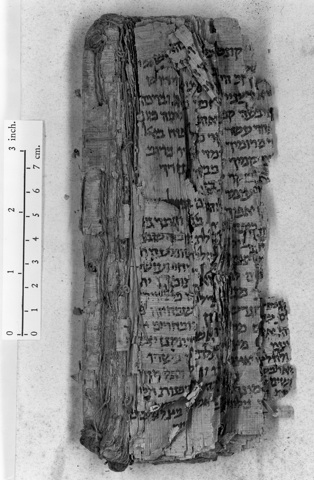T-S 6H9 – 21, the papyrus codex rebound
In the course of research into ancient book-binding practices and their relevance to the conservation of the sewn structures preserved in the Jacques Mosseri Genizah Collection, I rediscovered some very interesting negatives in the archives of the Library’s Imaging Services Department. The negatives—long thought lost—show the Taylor-Schechter Collection’s unique papyrus codex, T-S 6H9 – 21, as it was when it was first discovered, and I hope that they will prove of great interest to codicologists and historians of the early medieval book.
The late Professor Ezra Fleischer identified the fragments as a collection of liturgical poems by the Palestinian payṭan, Joseph b. Nissan of Neve Qiryatayim (a contemporary of Eleazar b. Kallir c. sixth century CE). At some point during the eighth or ninth century CE, a scribe copied Nissan’s poems out on to the papyrus leaves and the leaves were bound into a codex.

The payrus codex as Schechter discovered it
This codex, according to the University Librarian’s diary, was discovered by Solomon Schechter on 7 October 1897, just seven months after his Genizah hoard arrived at Cambridge. The codex was never studied properly and by the 1950s its poor state of preservation led the curators to consult with Dr Harold Plenderleith a conservation expert at the British Museum (1924–1959), and a certain Herr Ibsche of Berlin over the best way to conserve it. Following Plenderleith’s recommendations, a decision was made to separate out the folios and place them between glass. Two photographs of the codex were taken first in order to preserve a record of its original appearance and, according to the T-S Unit archives, the conservation treatment was afterwards carried out by Dr Jacob Teicher (former lecturer in Rabbinics at Cambridge University) together with a certain Mr Naish and a Mr Crane ‘during March & April 1951’. The photographs were published by David Diringer in The Hand-Produced Book (1953). Since that time, codicologists have had to rely upon a rather indistinct photograph to learn about its structure.
Colette Sirat’s later reconstruction of the codex based on the photographic evidence demonstrated that it was unique because:
- Of all the Genizah manuscripts, it is the only surviving example of a papyrus text
- It is the only known papyrus codex written in Hebrew characters
- The papyrus codex is probably one of the earliest medieval Hebrew books known to us
- The manuscript preserves evidence of a codex that was made up of a single gathering, a method thought to have died out in the fifth century CE.
It is very much hoped that the new digital images will assist codicologists to learn even more about this rare codex.
Readers are invited to send comments to genizah@lib.cam.ac.uk. The Taylor-Schechter Genizah Research Unit is not under any obligation to acknowledge or to publish comments.
Bibliography
CUL MS Add.7420 (1897) [Francis Jenkinson’s diary]
CUL archives of the Taylor-Schechter Genizah Research Unit [uncatalogued]
D. Diringer, The Hand-Produced Book (London: Hutchinson’s Scientific and Technical Publications, 1953).
R. J. W. Jefferson & N. Vince-Dewerse, ‘When Curator and Conservator Meet: Some Issues Arising from the Preservation and Conservation of the Jacques Mosseri Genizah Collection at Cambridge University Library’, Journal of the Society of Archivists 29/1 (2008), 41–56.
Sirat, C., Les Papyrus en Caractères Hébraïques Trouvés en Égypte (Paris: Centre National de la Recherche Scientifique, 1985).
Cite this article
(2009). T-S 6H9 – 21, the papyrus codex rebound. [Genizah Research Unit, Fragment of the Month, July 2009]. https://doi.org/10.17863/CAM.48228
If you enjoyed this Fragment of the Month, you can find others here.
Contact us: genizah@lib.cam.ac.uk
